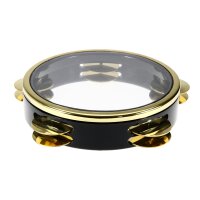Through many centuries, the Riq (or Riqq) has been the most important percussion instrument in countries such as Egypt, Lebanon, and Syria. Until 70 years ago, without the Riq Arabic arts music was simply unthinkable. Although the frame drum is not bigger than a plate, it is a highly esteemed instrument in classic Arabic music, due to its rich sounds and diverse sound colours, but also due to its demanding playing techniques that challenge the player. Today, in most ensembles the Riq has been replaced by the Darbuka, and, as a consequence, has eventually lost its significance. Nowadays, there are only a few musicians around that have mastered playing the Riq.
Adel Shams del Din is regarded as the most talented contemporary master of the Riq. He develops the virtuoso classic Riq playing technique further – with a style full of nuances as well as seemingly never-ending and continuously surprising rhythmic twists. Born in Alexandria, del Din has been living in Paris for almost 40 years and focuses on teaching his art, giving concerts with the Al-Kindi ensemble, and recording CDs. In 2012, another important Riq player, Michel Merhej Baklouk, from Lebanon published his textbook "Classical Riqq Technique", where he provides insights in his playing technique. Furthermore, inspiring Riq rhythms are to be found in the recordings of Umm Kulthum. For more than 40 years, the Riq player Ibrahim Afifi led the rhythm group of the orchestra from Umm Kulthum and ranks as one of the most influential Riq players. The Riq was the heartbeat of traditional Arabic orchestras. It controlled tempo and intensity of the music. Today, many percussion masters play the Darbuka as accomplished as the Riq.
The Riq is a tambourine. Traditonally, it is made out of a wooden frame with fish skin. The wooden frame has 5 bells, which come in pairs of twos. Those elaborately finished instruments have ornaments of little mosaics made of pearls, bone and horn or coloured wood.
The meaning of the Arabic word Riq translates as skin or parchment. It alludes to the thin drum skin which is partly responsible for the varied sounds. Precise, explosive beats are just as possible as subtle, tender and fragile sounds. The bells are a vivid element of the frame drum and contribute to an agile and powerful sound. The new Riqs are covered with synthetic material that is more robust than natural material. The drum skin of higher quality instruments can also be tuned.
The Riqs from DAN MOI were made in a Turkish facility that is committed to highest quality. It comes in two versions: the Riq Premium with bells of smooth brass and the Riq Pro with wrought brass bells that increase its sound variability. The frame made of mahogany is covered with a synthetic skin that provides excellent sound properties, and needless to say: those instruments are tunable.
The Riq is often held vertically with both hands on the lower side. The drum skin points away from the player's body. The thumbs hold the frame and the fingers are used to play. One bell is right in the middle of both hands. When the skin is being hit and the instrument is rhythmically moved or shaken the bells begin to make a sound. If the bells are intended to make only a few sounds the Riq is tilted a bit. If the player has trouble to hold the Riq it can also be placed in the lap, so the arms relieved.
Today, the Riq is also a popular percussion instrument in other parts of the world. Young percussionists use the Riq in their music to have another sound colour in their portfolio. This is true for players like Yshai Afterman, David Kuckhermann, or Glen Valez.



